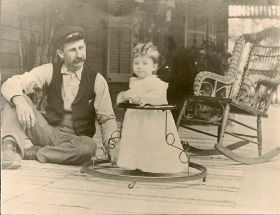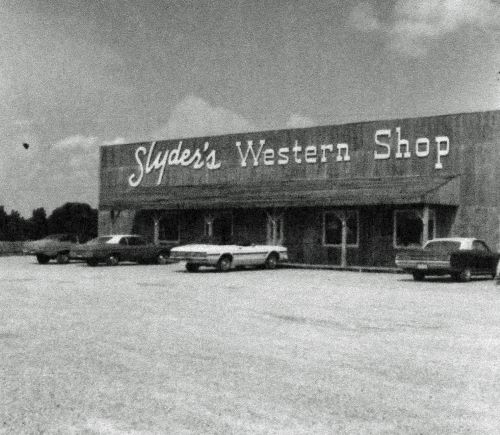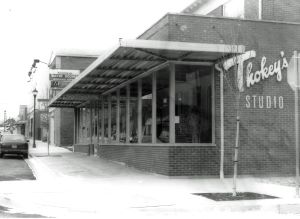|
|
A Peek at Brookville's Past
The articles below provide a glimpse of yesteryear in Brookville, Ohio. These articles and pictures are compiled from information contained in our vast collection on area businesses, people, events, calamities and other items too numerous to mention. An article appears each week in our local newspaper The Brookville Star. We hope you will enjoy reading these samples.
Early Kindergarden in Brookville
Mary Katherine Beachler opened a private kindergarten in her home at 502 Market Street on September 13, 1937. The first class had seven pupils. The hours were 9:00 to 11:00 on school mornings. All children near the age of five or more were eligible. Tuition was $1.50 per week. She continued to hold classes until 1956.
In April 1956, a meeting was held at the Brookville school auditorium to discuss problems concerning the opening of kindergarten classes in Brookville. About 100 parents and guests heard Supt. Hammond explain the new program. A description of the kindergarten facilities revealed that adequate space was available for an enrollment as great as 150. Also described were provisions made for the protection of health and safety, featured a fenced playground, radiant heat in the floor and was separated from the older pupils.
Due to a lack of state aid that year, the parents present voted to help defray expenses by a tuition rate of $1.00 week per pupil. Problems of transportation were discussed. The board of education would transport the pupils to school in the morning and home in the afternoon. There was no solution to the midday transportation problem. The majority of the parents in attendance expressed a desire to investigate a parent car pool plan as soon as the majority of kindergarten pupils were registered and their locations were plotted on a map to see if they could be grouped. If the car pool plan could be accomplished, the school said they would make an effort to place groups being transported together in the same session.
At that time 60 pupils had been registered. Mrs. Mary Katherine Beachler became the first kindergarten teacher employed by the school in 1956. She remained as a teacher until she retired in 1967. In 1971 Mrs. Beachler was named to the Board of the Community Preschool held at Community United Methodist Church.
All information and the photo for this Look at Brookville article were supplied by the Brookville Historical Society. Do you have a photo or historical information to share or add? Please contact the Brookville Historical Society at 937- 833-0285 or email to info@brookvillehistory.org
Samuel Spitler and his Daughter, Anona
 Samuel Spitler was born on Dec. 3, 1861, near Brookville and was the only child of Daniel and Prudence Litten Spitler. He lost his parents at the age of nine leaving him with two maiden aunts and a bachelor uncle, David Litten. Samuel Spitler was born on Dec. 3, 1861, near Brookville and was the only child of Daniel and Prudence Litten Spitler. He lost his parents at the age of nine leaving him with two maiden aunts and a bachelor uncle, David Litten. Under the supervision of his uncle he started his work career in the Litten flour mill. Later he operated a drug store, then he pursued his interest in things mechanical and in later years studied heating and hydraulic installations. He was the supervisor of the installation of the Brookville Water Pumping Plant.
He had a keen interest in all scientific innovations and was an accomplished photographer. He had a complete understanding of photographing technique and his work approached professional quality.
He married Ettie Weaver Spitler in 1889 and they had one daughter, Anona Spitler Stoner. In 1894, Samuel Spitler built what is now known as the Spitler House Community Museum. The house was erected for Mr. Spitler by Warren Rasor, a local craftsman. It was originally located at 15 Hay Avenue and was saved from demolition when the Brookville Historical Society formed in 1973. It was moved to its present location at 14 Market Street in 1974. It is one of Southwestern Ohio’s finest examples of Queen Anne Architecture. Samuel Spitler is credited with installing Brookville’s first indoor bathroom in this house. The house also had the first acetylene lighting system in Brookville. A generator was installed in the basement which charged and re-charged with carbide to produce the gas for overall lighting.
Mr. Spitlers wife, Ettie Spitler was a charter member of ’The Clio Club’ and many meetings were held at the Spitler Home. Also, the Brookville Library began in the early 1900s in this house. The house also was the original center and leadership for the Red Cross activities and war relief sewing during 1917-1918- later transferred to the Masonic Lodge room when more space was needed.
Shown in the picture are Samuel Spitler and his daughter Anona, which was taken around 1905 (note the early style walker). Anona was a 1922 graduate of Brookville High School and later graduated from Antioch College. She worked diligently with the Brookville Historical Society when the restoration of the Spitler House was being completed. It was restored as close to its original state as possible with her assistance, including wallpaper, floor coverings, paint and much more.
All information and the photo for this Look at Brookville article were supplied by the Brookville Historical Society. Do you have a photo or historical information to share or add? Please contact the Brookville Historical Society at 937-833-0285 or email to info@brookvillehistory.org
Parish Cemetery
.JPG)
The land for Parish Cemetery in Arlington was given to the people of the area by Henry B. Parish, who lived in Arlington, and purchased the ground from
the government in 1814. The earliest burial in Parish Cemetery is recorded as being that of Sarah Green in 1851 and the earliest born person buried th
ere is Michael Baker, born in 1768. Miss Mary Worman lived to be the oldest person buried there, dying in 1911 at the age of 103. The largest tombstone in Parish cemetery marks the grave of a man, James Dunlap, who lived the life of a hermit, thought to be destitute and without friends. In 1856, Dunlap vowed that if John C. Fremont didn’t win the presidential election that year, he would never cut his hair again. Fremont lost to James Buchanan and Dunlap kept his vow. A few of the older resident’s remembered the long flowing hair of Dunlap, who died in 1906 at the age of 71. The mausoleum at Parish Cemetery was built in 1918 and the first person to be placed in it was Dr. William S. Mundhenk of Brookville. In January 1928, W. W. Helwig collected funds to put a 9’2” Howitzer in the Parish Cemetery at Arlington. At first it was to be displayed at the Scott Hay residence but it was too heavy. Instead it was unloaded by derrick at the yard of the Brookville Bridge Works and put on display there. In May 1931, the Howitzer cannon was finally in place at the Parish Cemetery in Arlington. It was dedicated in memory of fallen war heroes. The speaker was Rev. Joseph P. Hendrix. The Brookville Band provided music.
 For 25 years the Slyder family brought to the Brookville area the interest in horsemanship. Young or Old, riding for pleasure or competition, it brought families together. We moved to the farm on Wellbaum Rd. in 1957. Soon each had a horse of their own and enjoyed riding country roads, meeting others and rode together. The few empty stalls soon filled with boarding horses and the need for equipment and supplies grew. Contacts were made to companies for these items, plans became reality, and the one car garage became the “Western Shop” in 1962. Soon needs were for boots, jeans, hats and clothing items. Horse shows every weekend. Central States Association made rules that were followed by the many clubs and 4H exhibiting thru the state. The opportunity to travel to events, involved in restoring a moving van, into a completely supplied ‘shop’. A good friend and employee did the driving and the guys attended and supplied many events over the years. In 1969 we bought the 36 acre Littten farm at auction on the corner of Brookville-Salem and Wellbaum Roads. Already thoughts of needed expansion were in mind. The new western shop was a priority and the 5000 sq. ft. store with balcony was completed and moved into spring 1972. Jim’s dream was still of an arena to serve not only the horse world, but to promote public activities. Plans with several interested investors advanced, with 10 acres deeded for the project, paper work, contractors, and construction started spring 1973. Over an acre under roof, 47,000 sq. ft., bleachers to seat 1500 people, a large kitchen and rest area. Also had an office, a show arena, and 20 stalls. The north side open for pens, rodeos, travelers, rest rooms. There was a parking lot for over 100 units. It was named “Cowtown Arena”. Later a car auction was held there, along with several open garage sales free for the public. Even a couple weddings, seemed no limit to activities. The end of the 1979 season offers were made on the building, by a Dayton company. Jim had some health problems and it was a hard decision for us to make. He died in 1984. The Western Shop remained open until the end of 1987. For 25 years the Slyder family brought to the Brookville area the interest in horsemanship. Young or Old, riding for pleasure or competition, it brought families together. We moved to the farm on Wellbaum Rd. in 1957. Soon each had a horse of their own and enjoyed riding country roads, meeting others and rode together. The few empty stalls soon filled with boarding horses and the need for equipment and supplies grew. Contacts were made to companies for these items, plans became reality, and the one car garage became the “Western Shop” in 1962. Soon needs were for boots, jeans, hats and clothing items. Horse shows every weekend. Central States Association made rules that were followed by the many clubs and 4H exhibiting thru the state. The opportunity to travel to events, involved in restoring a moving van, into a completely supplied ‘shop’. A good friend and employee did the driving and the guys attended and supplied many events over the years. In 1969 we bought the 36 acre Littten farm at auction on the corner of Brookville-Salem and Wellbaum Roads. Already thoughts of needed expansion were in mind. The new western shop was a priority and the 5000 sq. ft. store with balcony was completed and moved into spring 1972. Jim’s dream was still of an arena to serve not only the horse world, but to promote public activities. Plans with several interested investors advanced, with 10 acres deeded for the project, paper work, contractors, and construction started spring 1973. Over an acre under roof, 47,000 sq. ft., bleachers to seat 1500 people, a large kitchen and rest area. Also had an office, a show arena, and 20 stalls. The north side open for pens, rodeos, travelers, rest rooms. There was a parking lot for over 100 units. It was named “Cowtown Arena”. Later a car auction was held there, along with several open garage sales free for the public. Even a couple weddings, seemed no limit to activities. The end of the 1979 season offers were made on the building, by a Dayton company. Jim had some health problems and it was a hard decision for us to make. He died in 1984. The Western Shop remained open until the end of 1987.
Thokey Photo Studio
 Priser's Photo Studio operated at 104 Market Sytreet in Brookville beginning in the 1940's. Clarence Priser did professional photo work for many years. He also specialized in doing Brookville and other local school class pictures. In 1981, Mr. Priser left the photo business to become the pastor of a church in Sparta, North Carolina. Priser's Photo Studio operated at 104 Market Sytreet in Brookville beginning in the 1940's. Clarence Priser did professional photo work for many years. He also specialized in doing Brookville and other local school class pictures. In 1981, Mr. Priser left the photo business to become the pastor of a church in Sparta, North Carolina.
Larry Thokey, a Brookville native took over the studio when Mr. Priser left Brookville. Mr. Thokey, a graduate of Brookville High School in 1957, learned photography in the U S Army Photo School at Ft. Monmouth, New Jersey. While operating the photo studio, Mr. Thokey contributed much to the community. He was active in the Brookville Chamber of Commerce and the Rotary Club. He worked at the Community Picnic over the years and donated financially to the Brookville Community Scholarship Foundation. Mr. Thokey also did Brookville School's class pictures.
When Mr. Thokey left the Photo Studio in 1996, he too went into the Christian ministry just as his predecessor had done.
|
|

